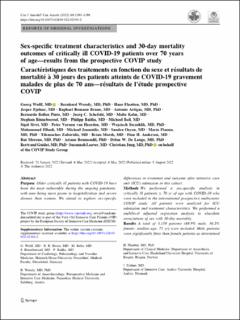Sex-specific treatment characteristics and 30-day mortality outcomes of critically ill COVID-19 patients over 70 years of age—results from the prospective COVIP study
Wolff, Georg; Wernly, Bernhard; Flaatten, Hans Kristian; Fjølner, Jesper; Bruno, Raphael Romano; Artigas, Antonio; Pinto, Bernardo Bollen; Schefold, Joerg C.; Kelm, Malte; Binneboessel, Stephan; Baldia, Philipp; Beil, Michael; Sivri, Sigal; van Heerden, Peter Vernon; Szczeklik, Wojciech; Elhadi, Muhammed; Joannidis, Michael; Oeyen, Sandra; Flamm, Maria; Zafeiridis, Tilemachos; Marsh, Brian; Andersen, Finn Husøy; Moreno, Rui; Boumendil, Ariane; De Lange, Dylan W.; Guidet, Bertrand; Leaver, Susannah; Jung, Christian
Journal article, Peer reviewed
Published version

Åpne
Permanent lenke
https://hdl.handle.net/11250/3030457Utgivelsesdato
2022Metadata
Vis full innførselSamlinger
- Department of Clinical Medicine [2066]
- Registrations from Cristin [9791]
Sammendrag
Purpose
Older critically ill patients with COVID-19 have been the most vulnerable during the ongoing pandemic, with men being more prone to hospitalization and severe disease than women. We aimed to explore sex-specific differences in treatment and outcome after intensive care unit (ICU) admission in this cohort.
Methods
We performed a sex-specific analysis in critically ill patients ≥ 70 yr of age with COVID-19 who were included in the international prospective multicenter COVIP study. All patients were analyzed for ICU admission and treatment characteristics. We performed a multilevel adjusted regression analysis to elucidate associations of sex with 30-day mortality.
Results
A total of 3,159 patients (69.8% male, 30.2% female; median age, 75 yr) were included. Male patients were significantly fitter than female patients as determined by the Clinical Frailty Scale (fit, 67% vs 54%; vulnerable, 14% vs 19%; frail, 19% vs 27%; P < 0.001). Male patients more often underwent tracheostomy (20% vs 14%; odds ratio [OR], 1.57; P < 0.001), vasopressor therapy (69% vs 62%; OR, 1.25; P = 0.02), and renal replacement therapy (17% vs 11%; OR, 1.96; P < 0.001). There was no difference in mechanical ventilation, life-sustaining treatment limitations, and crude 30-day mortality (50% male vs 49% female; OR, 1.11; P = 0.19), which remained true after adjustment for disease severity, frailty, age and treatment limitations (OR, 1.17; 95% confidence interval, 0.94 to 1.45; P = 0.16).
Conclusion
In this analysis of sex-specific treatment characteristics and 30-day mortality outcomes of critically ill patients with COVID-19 ≥ 70 yr of age, we found more tracheostomy and renal replacement therapy in male vs female patients, but no significant association of patient sex with 30-day mortality.
